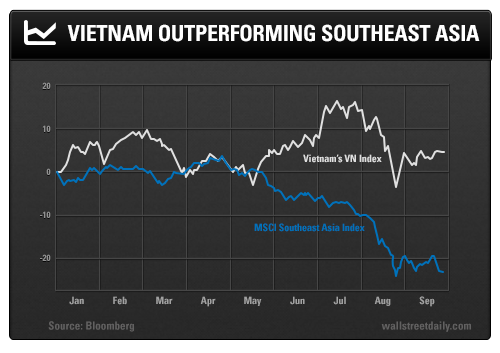These days, when investors hear the words “emerging market,” they immediately run in the opposite direction.
The Institute of International Finance reports that investors pulled $40 billion out of emerging markets in the third quarter alone. That’s the fastest pace since the height of the financial crisis and the largest outflow of funds since the fourth quarter of 2008.
But as a contrarian investor, I’m intrigued.
These outflows made me wonder if, in the panic for the exits, someone may have overlooked a gem. And sure enough, shining like a beacon in the dark, was Vietnam.
According to researchers at Capital Economics, Vietnam is one of just five emerging nations, as well as the only nation in Asia, whose economy is growing above its average growth rate since 2010.
Economists forecast that Vietnam’s $186-billion economy will grow at 6.1% this year and 6.2% in 2016. This follows growth of 5.2% in 2012, 5.3% in 2013, and 6% in 2014.
Capital Flowing to Vietnam
Vietnam has been able to attract productive capital inflows recently. In fact, it ranks seventh among all countries, including the United States and China, in foreign direct investment (FDI).
Most of that money is going into manufacturing. Vietnam is highly competitive in low-tech industries like textiles and footwear. But importantly, it’s also competitive in high-tech manufacturing. Vietnam has become a major exporter of smartphones, for example, and Samsung (KS:005930) has one of its largest global smartphone facilities there.
Thanks to the Vietnamese government, the economy’s momentum should continue. The government lifted the 49% ownership cap at a number of listed companies, which will allow foreign companies to invest heavily – or even take over – some Vietnamese firms.
In addition, the government has tamed inflation. In 1988, inflation was at an incredible 774%! Four years ago, it was still at 22%. Two years ago, it was down to only 6%. And today, inflation is negligible.
Vietnam’s Emerging Consumer Class
The growth of manufacturing jobs in Vietnam is changing the face of the country. Here are just a few examples:
-
The country has one of Asia’s fastest urbanization rates, which is creating a consumer middle class. According to the CIA World Fact Book, about a third of the population is now urban. The annual urbanization rate from 2010-15 is just under 3%.
-
Vietnam is now the fastest-growing auto market in Southeast Asia. Through August, year-on-year car sales were up a whopping 62%.
-
Vietnam’s internet penetration rate is rising faster than anywhere else in the world. With more than 40 million people connected to the internet, Vietnam has more users than any other country in Southeast Asia.
Not surprisingly, Vietnam has been Asia’s top performer in 2015. Its gain is only about 3.5%, but that looks fantastic compared to other stock markets:

It’s still relatively cheap, too, at just 12.5 times estimated earnings. And what really caught my eye is that the market is still trading about 50% below the peak level hit in 2007.
The only easy way for U.S. investors to play Vietnam is through an exchange-traded fund – the Market Vectors Vietnam Fund (NYSE:VNM). This ETF’s portfolio consists of 30 stocks, and it has about 75% of its assets invested directly into locally listed Vietnamese stocks. VNM has a very reasonable expense ratio of 0.7%.
The big drawback is that VNM has underperformed Vietnam’s index, showing a year-to-date loss of about 19%. This is likely due to the fund’s over-weighting in the most liquid, financial stocks, as well as energy stocks.
You can get much better performance with closed-end funds focused on Vietnam, which are traded in the over-the-counter market. The most liquid of these is the Vietnam Opportunity Fund (VCVOF). But even this one is very thinly traded. The advantage is that it’s trading 18% below its net asset value, so you’re buying assets at a discount in an already cheap market.
Finally, when – not if – emerging market sentiment turns, the upside could be substantial.
